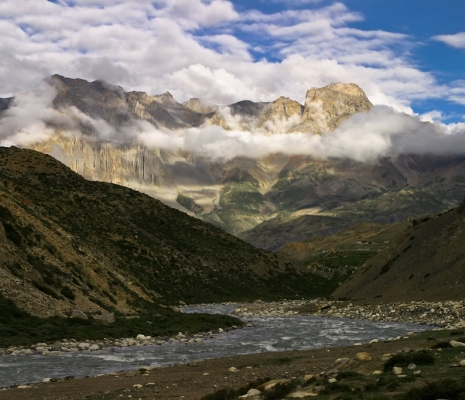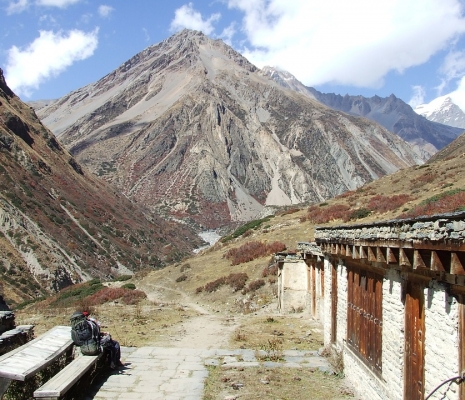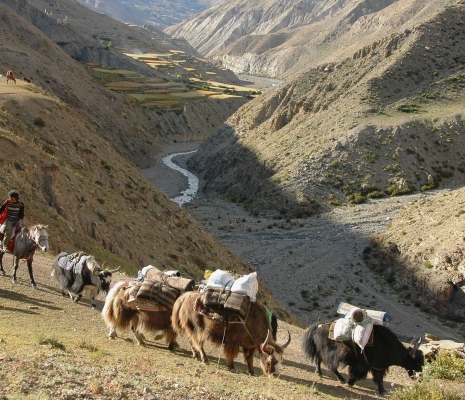Upper Dolpo Trek
- Duration : 24 Days Trip
- Altitude : 2 M
USD$1700USD$1500- starting price
Located in the western part of Nepal, Dolpo is one of Nepal's remote regions and was only open to trekkers after 1989. Running parallel to the mystical kingdom of Bhutan "Shangri-La", Dolpo is very rich in culture, ethics and vibrant surroundings. One must appreciate and observe the area's remoteness to experience the area's naturally unique landscape in the end. Dolpo is the district of Buddhism, which shelters around 5000 people. The region's people practice pre-Buddhist Bon Po religion that relies on mystical and shamanic practices from the early 18th century.
Dolpo is a photographer's paradise due to its unique attributes, including ancient religious traditions, sculpture, architecture and people. The warm hospitality of local communities and the fascinating insight into Tibetan culture make this trek a lifetime experience. Upper Dolpo trek follows the old Tibetan salt caravan path through the mountains. Spring (March to May) and autumn (September to October) are the best months for the Upper Dolpo hike. Since the Dolpo region lies in the rain shadow area created by the two Dhaulagiri and Annapurna peaks ranges, this trip is possible during the Monsoon season (June to August).
Itinerary
View short itinerary
Day 1
Fly from Kathmandu to Nepalgunj
As we start our tour we take an hour’s flight to Nepalgunj which is situated in the south-west border of Nepal and India. The place is hot and tropical as being situated in the Terai region of the country. Overnight at Nepalgunj.
Day 2
Fly from Nepalgunj to Juphal (Dolpo) and trek to Dunai (2,850m/9,348ft): 45 mins flight, 2-3 hours trek
We start our day by flying to Juphal situated at the height of 2,320m. Juphal will be our start point of the trek. A short 2-3 hours walk from the Juphal airstrip leads us to Dunai which will be our stop for the night.
Day 3
Dunai to Ankhe (2,896m/9,499ft): 5-6 hours
As we start walking from the camp at Dunai, the route starts diverting from the King Mahendra’s statue crossing the new suspension bridge. The path soon begins to climb up the side of a treeless valley, Thulo Bheri, where it slightly elevates to a ridge and then enters the Phoksundo river valley. The walk then leads to a large side canyon which descends gently on the long downhill slope through the scattered houses and walnut groves to a stream at 2,810m the trail below the stream leads to Dhera. However, the route leads the upper trail climbing to Rahagaon, a Thakuri village at 2,900m, having a Gompa dedicated to the local god, Mastha, guardians of this village. Trek from here passes through the lower part of Rahagaon and then descending to the village water supply at the Phoksundo Khola. Passing through another canyon, the path heads downhill through deep dark forests to a large stream, finally emerging at the entrance to the Shey Phoksundo National Park at Ankhe (2,896m) which will be our stop for the night.
Day 4
Ankhe to Sulighat: 5-6 hours
The path from Ankhe to Sulighat is full of ups and downs. Nevertheless, the streams flowing alongside are the best attraction of the path. The trail travels through a grassy slope above the river leaving the forest. The trails then become to turn into a collection of rocks and sticks forming a dike along the river bank. The walk continues upstream to a bridge near Ryajik village which will be the stop for the night.
Day 5
Sulighat to Phoksundo Lake (3,611m/11,849 ft) 4-5 hours
We move forward towards the Phoksundo lake today. We start the day by crossing the western side of Phoksundo lake crossing the lake through a wooden bridge and leading to the west bank of the Pungmo Khola. The path passes through a cedar forest and finally to Palam, a winter settlement used by the people of Ringmo village. From here our route elevates up to the open country, at an altitude of around 3,350m. A magnificent view of the Phoksundo Lake from the ridge is like a cherry to the pie. After a brief stop here with the great views, finally, the walk descent through birch forests to the upper reaches of the Phoksundo Khola, and then to the picturesque settlement of Ring mo with its mud-plastered Chortens and Mani walls. From here it is a short walk to the shores of Phoksundo Lake for the overnight at camp.
Day 6
Acclimatization and rest at Phoksundo Lake
Phoksundo Lake is situated in a high altitude works as the acclimatization stop for trekkers to avoid altitude sickness. Hence, we stroll around the village of Ringmo and its Tibetan Buddhist Monastery and enjoy our rest day at the lake.
Day 7
Trek to Phoksundo Khola: 4-5 hours
The trail follows the edge skirting the lake. We trail very steeply up, to 4,040meters, and then plunge down again to the valley bottom to enter the floodplain of the Phoksundo Khola and trek to your night stop alongside the river.
Day 8
Phoksunds Khola to Phoksundo Bhanjyang: 6-7 hours
We continue along the level path through a glacial valley heading north. As the trail becomes narrower, there are impressive vertical cliffs and twisted rock formations. We then take the barely apparent path to the northeast up a side valley which has a cavernous look. These types of trails are very rare. A long climb brings you to a sheep meadow where the trail veers up a steep gorge. A hard climb to the top brings you to yet another valley where you can see the Kang La, the pass will lead you to Shey Gompa.
Day 9
Phoksundo Bhanjyang to Shey Gompa (4,500m/14,760ft) via Kang-La pass (5,360m/17,581ft): 5-6 hours
It will take about two and a half to three hours to reach the top of the Kang La pass. The views from the top are magnificent and well worth all the hard work you have done to reach the pass. On descending steeply to the valley floor, not more than 45 minutes, you make a long winding trek along the banks of the river, crossing it once. Finally, we arrive at Shey Gompa where a quaint wooden log bridge leads up to the Shey compound.
Day 10
Acclimatization and rest at Shey Gompa
As the name Shey suggests crystal, this monastery is also known as the Crystal Mountain. People call it a retreat rather than a monastery. The monastery was built during the 11th century. Shey is famous for its ancient Buddhist culture. In Dolpo, the ancient Tibetan way of life combines animism with the teachings of Buddha. Drutup Yeshe introduced Buddhism in the Dolpo valley. Many years ago he came to Dolpo and came across wild people, whose supreme God was a 'fierce mountain spirit'. Crystal Mountain is to the west of the Shey monastery. It is a very strange mountain indeed. Its contorted cliffs are laced with quartz and embedded with a rich variety of marine fossils. Shey Gompa stands above the junction of Kangjunala and Jeju Nala. Near the confluence, there is a group of prayer mills turned by water wheels.
Day 11
Shey Gompa to Namduna Gaun (4,800m/15,744ft) via Saldang La (5,200m/17,056ft): 6-7 hours
Our day begins descending through a trail into a grey, stony canyon leading to a zig-zag path over bare rocks as we reach Saldang-la. As we move forward, we are welcomed by sight of pastures of grazing yaks and sheep, and nomadic tents made from yak hair which signals our approach to Namduna Gaun 4,800m. Like Shey, the Namgung monastery is of the Karma-pa sect which is a red stone structure and is built against the backdrop of a cliff on the north wall of a gorge. We spend the night at Namduna Gaun.
Day 12
Namduna Gaun to Saldang (3,620m/ 11,874ft): 4-5 hours
As our route starts climbing up a long traverse along some barren dusty mountains for roughly 4 hours, we approach a picturesque village of Saldang. It is the largest village of the inner Dolpo area as the village stretches for nearly 2 km. We spent the night in Saldang.
Day 13
Saldang to Yangze Gompa (4,960m/16,267ft): 4-5 hours
We follow the Nang Chu river diverting further far north. This trail is unexplored by westerners or by any commercial adventure trekkers. A fairly gradual path with few ups and downs are in store while we walk today. We pass through the small settlement of Tiling and Lurigaon till we reach our overnight camp at Yangze also known as Yangtsher, just before Yangze near Lurigaon.
Day 14
Yangze Gompa to Sibu (4,560m/14,957ft): 6-7 hours
Amongst the 2 parts connecting Sibufrom Yangze, we take a shorter and easier path towards Saldang. We walk past the trail following the river bed we pass through terraced fields, stupas, Chortens, heaps of Mani stones and a Chaiba monastery, then passing through the Namdo village which is also prosperous with about sixty houses having nearly 400 inhabitants. We continue our journey further down the river for another two hours to camp near the small settlement of Sibu.
Day 15
Sibu to Jeng-la Phedi (4,900m/16,072ft): 5-6 hours
The trail follows the Nam Khong Khola for a while on the morning walk coming across caravan of laden yaks that are on their way towards Tibet border. From here our walk leads to a steep climb to the bottom of Jeng la (4,900m), where we stay for the overnight on a nice meadow.
Day 16
Jeng-la Phedi to Tokyu Gaon (4209m/13809ft) via Jeng La pass (5,090m/16,695ft): 5-6 hours
Today’s walk starts climbing towards the top of Jeng La for roughly around 2 hours also noticing the glimpses of snow range emerging in the south and Dhaulagiri smiling to you from the north.
After a wonderful moment here at the pass, our walk leads to descend on the rough path towards Tarap valley. By afternoon we come to the green valley which leads us on the pleasant track down towards Tarap Chu. We stop for the night at Tokyu monastery.
Day 17
Tokyu to Dho Tarap(4,040m/13,251ft): 4-5 hours
Today, the route leads eastward along the downhill course of Tarap Chu in a plain valley with patches of lush grass on both sides of the river which is completely different from other parts of inner Dolpo. After a short trek on this beautiful valley, we arrive Dho Tarap (4,040m/13,251ft) for the overnight camp.
Day 18
Rest Day at Dho Tarap
Today, we have a full rest day or exploration of local areas. However, we can hike to the Buddhist Gompa which is the nearest one to the campsite; the Bon Gompa takes 40 minutes to reach.
Day 19
Dho Tarap to Tarap Khola (Kamakharka) (3,800m/12,464ft): 6-7 hours
From the quite bare country around Tarap, we descend towards a wide valley which eventually narrows into a gorge. We walk along with the bushes and wild roses, typical of dry inner Himalayan valleys, to just above the tree line. On this route, we might see herds of blue sheep as we reach to the Tarap Chu and the Lang Khola, a stream that joins with Tarap River from further east.
Day 20
Tarap Khola to Khanigaon(3,150m/10,332ft): 4-5 hours
This morning again continues down the gorge of the Tarap River, at times alongside it, rising high above on a trail built from the steep slopes. This will be one of the exciting days of this trip, as the valley becomes so narrow in a deep gorge that in some places we can jump from one side to another as we finally reach to the camping spot beside the Tarap Khola at Khanigaon (3,150m) we stop for overnight stay.
Day 21
Khanigaon to Tarakot (2,537m/8,321ft): 4-5 hours
Today from Khanigaun the path follows a foggy trail to the village of Lalberi before descending into another gorge our walk continues following the river again downstream to reach Tarakot. Tarakot (2,537m) is an old fortress town known by the local people as Dzong, meaning ‘fort’ which will be our stop for the night.
Day 22
Tarakot to Dunai (2,140m/7,019ft): 5-6 hours
Today’s walk continues beside the Bheri River in a tremendous gorge with pine trees and a path built about seven meters above the river until we reach Dunai which will be our stop for the night.
Day 23
Dunai to Jhuphal: 2-3 hours
We head back to Jhuphal from Dunai walking for roughly 2-3 hours, which is a short distance walk along the Bheri River to the small airstrip for the last night of the trek.
Day 24
Fly from Jhuphal to Nepalgunj and Nepalgunj to Kathmandu
Today we head back to where we started. We take a flight of around 35 minutes back to Nepalgunj and then another 20 mins flight back to Kathmandu.
Cost Includes
- Airport pickup and drop in a private vehicle.
- 3 Nights twin sharing hotel accommodation in Kathmandu on Bed & Breakfast basis.
- Full day Kathmandu sightseeing tour by private tourist vehicle.
- Professional English speaking tour guide during Kathmandu sightseeing.
- All standard meals (Breakfast, Lunch & dinner) during the trek.
- Best available lodge/Guesthouse accommodation during the trek.
- License holder English speaking trekking guide.
- Porter service (2 trekkers: 1 Porter).
- Food, accommodation, salary, equipment, medicine & insurance for all staff.
- Necessary entry permits fees & traveler TIMS card.
- Company provide sleeping bag & duffel bag (to be returned after trip completion).
- All government & local taxes.
Cost Excludes
- International airfare & necessary airport taxes.
- Nepal entry visa fees at present USD 25 for 15 days, USD 40 for 30 days and USD 100 for three month.
- Lunch and dinner in Kathmandu.
- Temple & monasteries entry fees during sightseeing in Kathmandu.
- Travel insurance which covers emergency rescue & evacuation.
- Extra night accommodation in Kathmandu because of early from mountain or late departure.
- All personal & bar expenses in Kathmandu during the trek.
- Tips for trekking staff & driver (tipping is expected).
- Personal expenses (phone calls, laundry, battery recharge, extra porters, bottle or boiled water, shower etc) and any other expenses which are not mentioned above.
Challenging
Spring & Fall
Dolpo
2-20 people
Hotel, Lodge & Tea House
Have questions ? we are here
Give a direct call to our experts and get started.
+977-9852076345
Have questions ? we are here
Give a direct call to our experts and get started.
+977-9852076345
Company Address
- Company Name: Lekhbesi Holidays Pvt. Ltd.
- Regd No.: 149030/72/073
- Website : lekhbesi.com
- E-mail: info@lekhbesi.com
- Contact: +977-9852076345
- Address: Itahari, Sunsari, Nepal





